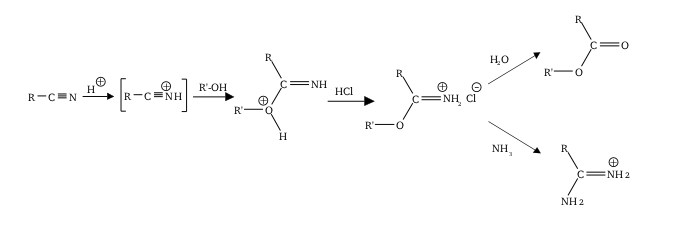
Pinner reaction
Encyclopedia
The Pinner reaction is an organic reaction
of a nitrile
with an alcohol
under acid
catalysis
for instance hydrochloric acid
. The product formed is the hydrochloric acid salt of an imino ester or an alkyl imidate, which sometimes is called a Pinner salt. The reaction is a sequence of nucleophilic addition
s.
These salts can react with an excess of alcohol to form the orthoester
RC(OR)3, with ammonia
or an amine
to form an amidine
or with water to form an ester
.

IUPAC Nomenclature for Transformations
: Alkoxy,oxo-de-nitrilo-tersubstitution, another name for this reaction is nitrile alcoholysis.
Organic reaction
Organic reactions are chemical reactions involving organic compounds. The basic organic chemistry reaction types are addition reactions, elimination reactions, substitution reactions, pericyclic reactions, rearrangement reactions, photochemical reactions and redox reactions. In organic synthesis,...
of a nitrile
Nitrile
A nitrile is any organic compound that has a -C≡N functional group. The prefix cyano- is used interchangeably with the term nitrile in industrial literature. Nitriles are found in many useful compounds, one example being super glue .Inorganic compounds containing the -C≡N group are not called...
with an alcohol
Alcohol
In chemistry, an alcohol is an organic compound in which the hydroxy functional group is bound to a carbon atom. In particular, this carbon center should be saturated, having single bonds to three other atoms....
under acid
Acid
An acid is a substance which reacts with a base. Commonly, acids can be identified as tasting sour, reacting with metals such as calcium, and bases like sodium carbonate. Aqueous acids have a pH of less than 7, where an acid of lower pH is typically stronger, and turn blue litmus paper red...
catalysis
Catalysis
Catalysis is the change in rate of a chemical reaction due to the participation of a substance called a catalyst. Unlike other reagents that participate in the chemical reaction, a catalyst is not consumed by the reaction itself. A catalyst may participate in multiple chemical transformations....
for instance hydrochloric acid
Hydrochloric acid
Hydrochloric acid is a solution of hydrogen chloride in water, that is a highly corrosive, strong mineral acid with many industrial uses. It is found naturally in gastric acid....
. The product formed is the hydrochloric acid salt of an imino ester or an alkyl imidate, which sometimes is called a Pinner salt. The reaction is a sequence of nucleophilic addition
Nucleophilic addition
In organic chemistry, a nucleophilic addition reaction is an addition reaction where in a chemical compound a π bond is removed by the creation of two new covalent bonds by the addition of a nucleophile....
s.
These salts can react with an excess of alcohol to form the orthoester
Orthoester
In organic chemistry, an orthoester is a functional group containing three alkoxy groups attached to one carbon atom, i.e. with the general formula RC3. The name can also refer to any organic compound that contains this functional group. An example of an orthoester is ethyl orthoacetate, CH3C3,...
RC(OR)3, with ammonia
Ammonia
Ammonia is a compound of nitrogen and hydrogen with the formula . It is a colourless gas with a characteristic pungent odour. Ammonia contributes significantly to the nutritional needs of terrestrial organisms by serving as a precursor to food and fertilizers. Ammonia, either directly or...
or an amine
Amine
Amines are organic compounds and functional groups that contain a basic nitrogen atom with a lone pair. Amines are derivatives of ammonia, wherein one or more hydrogen atoms have been replaced by a substituent such as an alkyl or aryl group. Important amines include amino acids, biogenic amines,...
to form an amidine
Amidine
Amidines are a class of oxoacid derivatives.The oxoacid from which an amidine is derived must be of the form RnEOH, where R is a substituent...
or with water to form an ester
Ester
Esters are chemical compounds derived by reacting an oxoacid with a hydroxyl compound such as an alcohol or phenol. Esters are usually derived from an inorganic acid or organic acid in which at least one -OH group is replaced by an -O-alkyl group, and most commonly from carboxylic acids and...
.

IUPAC Nomenclature for Transformations
IUPAC Nomenclature for Transformations
The IUPAC Nomenclature for Transformations is a methodology for naming a chemical reaction. Traditionally a chemical reaction especially in organic chemistry is named after its inventor, the so called named reaction, to name just a few: Knoevenagel condensation, Wittig reaction or Diels-Alder...
: Alkoxy,oxo-de-nitrilo-tersubstitution, another name for this reaction is nitrile alcoholysis.

